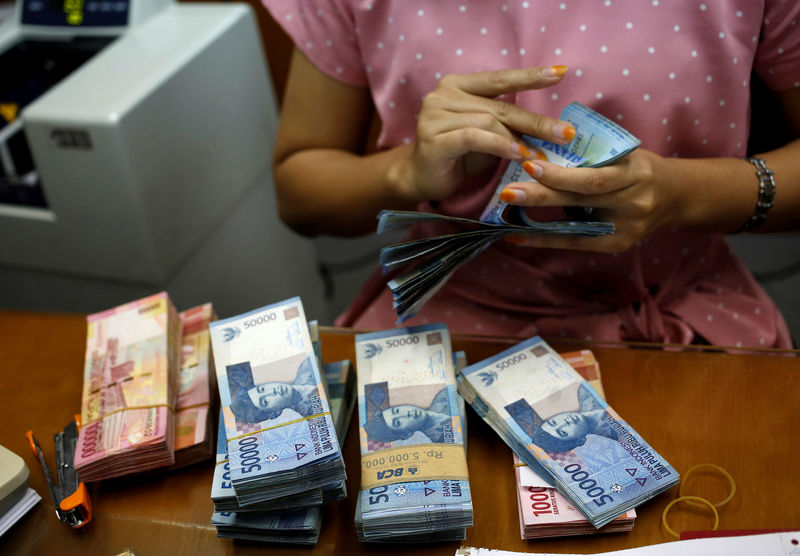 © Reuters. FILE PHOTO: A teller counts Indonesian rupiah bank notes at a money changer in Jakarta
© Reuters. FILE PHOTO: A teller counts Indonesian rupiah bank notes at a money changer in JakartaBy Maikel Jefriando and Fransiska Nangoy
JAKARTA (Reuters) – Indonesia’s central bank raised its benchmark interest rate for the fifth time since mid-May on Thursday and introduced an instrument aimed at helping the rupiah by encouraging foreign investors to do their currency hedging onshore.
Hours after the Federal Reserve hiked U.S. interest rates for the third time this year, Bank Indonesia (BI) increased its benchmark interest rate
The extension of BI’s tightening cycle takes the increase in the benchmark to 150 bps points since mid-May, when Indonesia suffered capital outflows as U.S. Treasury yields rose, and investors worried about its trade and current account deficits.
Many analysts, including those at Nomura and Bank Danamon in Jakarta expect more hikes. Gareth Leather of Capital Economics in London said Thursday’s increase showed that Indonesia’s tightening cycle was “not over yet”.
All but two of 25 analysts in a Reuters poll anticipated a hike on Thursday, and 20 predicted a 25 bps increase.
“BI will not hesitate to take stabilization measures and guard the rupiah’s exchange rate,” said Governor Perry Warjiyo, who described the bank’s policy stance as remaining “hawkish”.
This year, the rupiah
After Thursday’s announcement, the currency weakened slightly to 14,910 a dollar, from 14,905.
To supplement its rate hikes, BI will allow domestic non-deliverable forward transactions of rupiah against a number of currencies to provide an alternative hedging product for both foreign investors and local corporations with forex needs, the governor said.
BI wants them to use the onshore market instead of offshore NDFs, where future rates are currently weaker than in the onshore forward market.
WANTED: MARKET DEEPENING
“This is an integral part of BI’s efforts to stabilize the exchange rate as well as an acceleration of forex market deepening,” Warjiyo said, adding that he hopes the domestic NDF market will pick up as soon as possible.
Nomura said the domestic NDF plan “should not necessarily change underlying demand and supply for FX onshore”, though it may help spread out demand in the spot market.
However, if it is successful in bringing overseas hedging onshore, it could boost forex liquidity in the domestic market, said Bank Danamon economist Wisnu Wardana.
To defend the rupiah this year, BI has spent billions in currency intervention, while the government has raised import tariffs, widened biodiesel use and delayed big infrastructure projects to reduce imports.
Authorities have also tried to coax exporters to sell more of their dollar earnings to increase onshore dollar supply and reduce pressure on the rupiah.
Erwin Rijanto, a BI deputy governor, said banking liquidity is expected to be tight this year with growth in savings seen coming in below 9.4 percent – mostly because of slower growth in savings in foreign currencies – while credit growth is predicted to reach 10-12 percent.
BI on Thursday left unchanged its 2018 economic growth forecast at 5.0-5.4 percent and 5.1-5.5 percent next year.
With BI’s 25 bps hike plus a 50 bps one by the Philippine central bank on Thursday, the two have been the most aggressive this year, lifting their benchmark rates by 1.5 percentage points.
Indonesia’s hikes, unlike those in the Philippines, are not rooted in inflation concerns. August’s annual inflation rate was 3.20 percent, comfortably inside BI’s target range and Warjiyo said it will remain in target until 2019.
Source: Investing.com





























